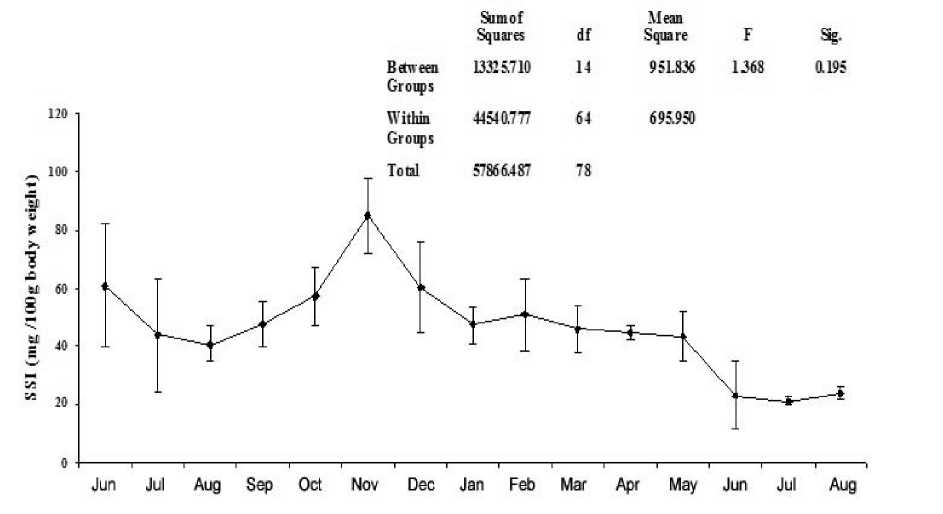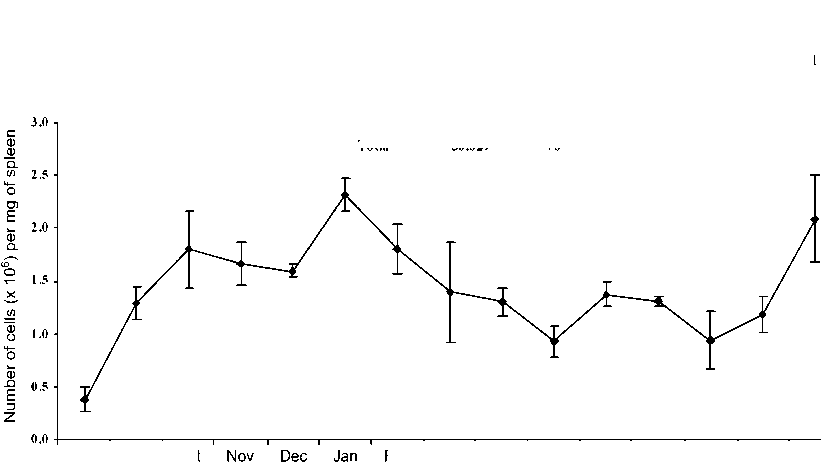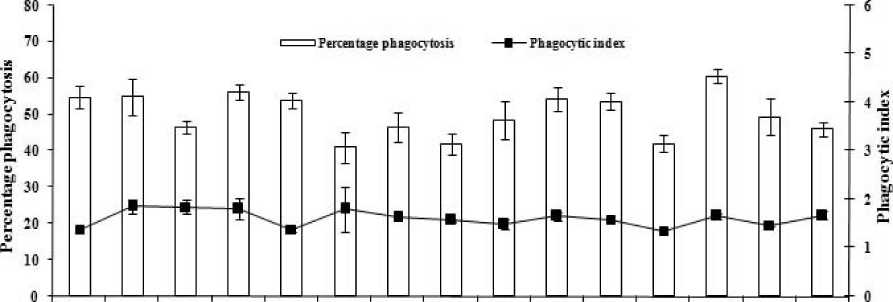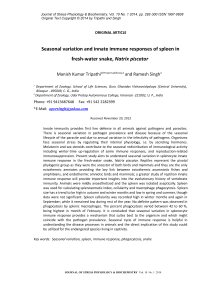Seasonal variation and innate immune responses of spleen in fresh-water snake, Natrix piscator
Автор: Tripathi Manish Kumar, Singh Ramesh
Журнал: Журнал стресс-физиологии и биохимии @jspb
Статья в выпуске: 1 т.10, 2014 года.
Бесплатный доступ
Innate immunity provides first line defense in all animals against pathogens and parasites. There is seasonal variation in pathogen prevalence and disease because of the seasonal lifecycle of the parasite and due to annual variation in the infectivity of pathogens. Organisms face seasonal stress by regulating their internal physiology, i.e. by secreting hormones. Melatonin and sex steroids contribute to the seasonal redistribution of immunological activity including winter-time up-regulation of some immune responses, and reproduction-related immunosuppression. Present study aims to understand seasonal variation in splenocyte innate immune response in the fresh-water snake, Natrix piscator. Reptiles represent the pivotal phylogenic group as they were the ancestor of both birds and mammals and they are the only ectothermic amniotes providing the key link between ectothermic anamniotic fishes and amphibians, and endothermic amniotic birds and mammals; a greater study of reptilian innate immune response will provide important insights into the evolutionary history of vertebrate immunity. Animals were mildly anaesthetized and the spleen was isolated aseptically. Spleen was used for calculating splenosomatic index, cellularity and macrophage phagocytosis. Spleen size has a trend to be high in autumn and winter months and low in spring and summer, though data were not significant. Spleen cellularity was recorded high in winter months and again in September; while it remained low during rest of the year. No definite pattern was observed in phagocytosis by splenic macrophages. The percent phagocytosis varied between 42 to 60 %, being highest in month of February. It is concluded that seasonal variation in splenocyte immune response provides a mechanism that suites best to the organism and which might coincide with the pathogen prevalence. Seasonal cycle of immune response is helpful in understanding the disease processes in animals and the direct implication of this study could be utilized for the endangered species living in captivity.
Seasonal variation, spleen, immune response, phagocytosis, snake
Короткий адрес: https://sciup.org/14323840
IDR: 14323840
Текст научной статьи Seasonal variation and innate immune responses of spleen in fresh-water snake, Natrix piscator
Changes in environmental factors throughout the year determine season of the year. The photoperiod is primary cue used by most of the organisms as a seasonal marker, because it is the most reproducible and predictable sign of the changing season (Goldman, 2001; Prendergast et al., 2002). Nevertheless, the changes of ambient temperature, humidity or food access may also be used as seasonal cues. The environmental changes drive the organism’s seasonal rhythms in some species; whereas in others, these merely synchronize the endogenous circannual rhythms with the season of the year (Hoffman and Reiter, 1965).
Several physiological processes, including growth, cellular maintenance, immune function, thermogenesis, and reproductive processes are energy demanding (Merino et al ., 2000; Sinclair and Lochmiller, 2000). Most non tropical species, not buffered from potentially dramatic seasonal changes in their environment, may presumably become sick and die from a direct failure to balance their energetic demands due to exposure to extreme seasonal stresses. Many animals, however, die indirectly from opportunistic diseases that seem to overwhelm immunological defense, presumably at times when these defenses are low (Nelson and Demas, 1996; Lochmiller and Deerenberg, 2000).
To increase survival, one strategy is to enhance immune function prior to the onset of the poor conditions that may compromise immune function. Maintaining maximal immune function is energetically expensive; the cascade of dividing immune cells, the onset and maintenance of inflammation and fever, and the production of humoral immune factors, all require significant energy (Demas et al., 1997). Mounting an immune response requires resources that could otherwise be allocated to other biological functions (Sheldon and Verhulst, 1996). Thus, maintaining a positive energy balance is required for survival and reproductive success. Individuals may partition resources among the immune system and other biological processes, such as reproduction, growth, or thermogenesis. Consequently animals may attain the highest level of immune function that is energetically possible given the constraints of processes essential for survival, growth, reproduction, thermogenesis, foraging and other activities (Deerenberg et al., 1997).
Recent evidences suggest that immune function varies substantially on a seasonal basis (Lochmiller et al ., 1994; Nelson and Demas, 1996), and a direct link between seasonal fluctuation in the environment and specific immunological changes has been established in several studies that have provided evidence for reduced immune function and increased death rates from infectious diseases during the winter (Nelson et al ., 1995; Nelson and Demas, 1996; Sinclair and Lochmiller, 2000).
Seasonal cycles in the development, regression, and regeneration of the thymus, spleen, and bursa of Fabricius (in birds) have been described in many vertebrate species (Nelson et al ., 2002); relatively less is known for non-mammalian vertebrates. In reptiles, earlier studies have demonstrated that these are also endowed with an advanced type of immune system: bone marrow, thymus, spleen and gut-associated lymphoid tissues are well developed (Hussein et al ., 1979; Mansour et al ., 1980). The functional relevance of the reptilian spleen has been demonstrated, as splenectomy in lizards causes an acute inhibition of several immune responses (Jayaraman and Muthukkaruppan, 1977), and spleen is the major site of immune responses to blood-borne antigens and is also a site of hematopoiesis (Batista and Harwood, 2009).
Reptiles have an extended terrestrial lifestyle and they show direct development without metamorphosis. Reptiles are generally long-lived, with an extended period of growth and maturation early in life. However, reptiles are unable to internally regulate their body temperature, and undergo strong seasonal change in behavior associated with environmental temperatures. Collectively, these characteristics may have profound effects on how reptiles partition energy resources to self-maintenance activities. A greater knowledge of reptilian immunity is required to understand the evolutionary history of vertebrate immunity (Zimmerman et al., 2010). This warrants more and more studies in reptiles.
MATERIALS AND METHODS
Animals
Chemicals
Culture medium (RPMI-1640), L-glutamine, Gentamycin, fetal bovine serum (FBS), dimethyl sulfoxide (DMSO), and other chemicals were purchased from Himedia Laboratories Pvt. Ltd. (India).
The culture medium was supplemented with 1 µl ml-1 Gentamycin, 10 µl ml-1 of 200 mM L-glutamine, 10 µl ml-1 anti-anti (Gibco) and 5% FBS and referred to as complete culture medium.
Experiment
To study seasonal variation in immune functions, the requisite number of animals were sacrificed under mild anesthesia during mid of each month. Spleen was excised aseptically, weighed immediately, and Spleno-somatic index (SSI: spleen weight per 100 g body weight) was calculated. Excised spleens were kept in cool (4oC) culture medium and soon after utilized to study cellularity and macrophage phagocytosis. In all study, sample size was 5 to 6.
Preparation of spleen single cell suspension
Under aseptic conditions, excised spleen was immediately macerated through a nylon strainer of pore size <100 µm into complete culture medium (2 ml/spleen) to get single cell suspension under a sterile laminar flow hood. Cell viability was checked light microscopically through trypan blue exclusion test, which exceeded 95%. Spleen cellularity (number of splenocytes mg-1 tissue) was determined with help of hemocytometer and light microscope.
Preparation of macrophage monolayer
Splenic macrophage monolayer was prepared, and phagocytic assay was performed following the method of Mondal and Rai (1999a, 1999b, 2001). Briefly, splenic cell suspension (200 µl) was flooded onto individual pre-washed and sterilized glass slides. Phagocytic macrophages were allowed to adhere by incubating the slides at 25oC in humidified CO2 atmosphere for 90 min. Non adherent cells were washed off with 0.2 M phosphate buffer saline (PBS; pH 7.2). The splenic macrophage monolayer was prepared in duplicate from each spleen. In the adherent cell population, more than 90% of the cells were macrophages as judged by their morphology.
Phagocytic assay
For phagocytic assay, the yeast cells were used as target cell. The yeast cell suspension was prepared by mixing 20 mg of commercial baker’s yeast ( Saccharomyces cerevisae ) in 10 ml of 0.2 M PBS. The suspension was kept at 80oC for 15 min. The cells were washed three times in PBS and finally suspended in the complete culture medium to get a concentration of 1x108 cells ml–1.
The prepared macrophage monolayer, as above, was flooded with yeast cell suspension, and phagocytosis was allowed to proceed. After 90 min incubation at 25oC in humidified CO 2 atmosphere, the slides were rinsed three times in PBS, fixed in methanol, stained with Giemsa, and examined under oil immersion. For each slide, a total of 100 macrophages were examined randomly without any predetermined sequence. The phagocytic index was determined by calculating the average number of yeast cells engulfed by single macrophage. The percent phagocytosis was calculated by dividing the number of macrophages showing phagocytosis by 100.
Statistical analysis
Data are presented as Mean ± SEM. Means were compared by ANOVA.
RESULTS AND DISCUSSION
Analysis of variance reveals that there was no significant variation in splenic mass of the freshwater snake during different months of study period, though spleen size has a trend to be high in autumn and winter months and low in spring and summer (Fig. 1). Spleen cellularity was recorded high in winter months and again in September; while it remained low during rest of the year (Fig. 2). No definite pattern was observed in phagocytosis by splenic macrophages. The percent phagocytosis varied between 42 to 60 %, being highest in month of February (Fig. 3).
Lymphatic organs like spleen, thymus and bursa of Fabricius (in birds) are important immune organs. Seasonal cycles of lymphatic organ mass have been recognized well before the immunological functions of these organs identified. In various studies, early as well as recent, the immune status of the animal has also been assessed indirectly through changes in gross lymphatic organ mass that presumably reflect immunologic activity of the tissue. It is logical also to assume that lymphatic organ mass positively correlates with organ function; this assumption is common with that associated with the seasonal changes in reproductive organ mass. A relatively large number of studies have reported seasonal changes in lymphoid tissue, with a trend toward regression of lymphoid tissue during the mating period and winter, compared with other times of the year.
In the present study, spleen size and spleen cellularity were found to have a trend to be high in autumn and winter months and low in spring and summer. El Ridi et al. (1981) have reported seasonal variation in the spleen of snake, Psammophis schokari. Red pulp is well developed; while the white pulp had only a few scattered aggregates during winter. However, during summer, the red pulp was indistinct with lymphatic tissue regressing in size. In avian species, relative splenic size undergoes a reduction at the beginning of breeding season in both migratory and non migratory birds; regeneration of spleen occurs during subsequent incubation and feeding of the hatchlings (Oakson, 1956; Fange and Silverin, 1985). Reduction in splenic mass during winter compared to summer and spring is recorded in short-tailed voles, Microtus agrestis (Newson, 1962). On the other hand, increase in splenic mass during winter is reported in deer mice (Demas et al., 1997). Elevated splenic mass has been reported during September and October in red-backed mice, Clethrionomus rutilus (Sealander and Bickerstaff, 1967). Splenic and thymic sizes have been reported to be minimal in several avian species when the gonads begin the process of vernal recrudescence (Oakeson, 1956; Fange and Silverin, 1985). In avian species also, thymus has been reported to be minimal when the gonads were undergoing vernal recrudescence (Nelson et al., 2002).
Phagocytes are the most important components of the non-specific cell-mediated immune system (Neumann et al ., 2001), as they play a major role in clearing foreign particles in tissues. We found higher percentage phagocytosis during spring and summer; while phagocytic index was higher in spring in N. piscator . In vivo experiments by Le Morvan et al . (1997) showed that head kidney macrophages of carp ( Cyprinus carpio ) display better phagocytic capacity at temperature, 12 0C than at higher temperatures, 20 or 28 0C. A similar pattern was observed in T. tincta , where the blood granulocytes showed higher capacity to phagocytose latex beads and to produce oxidative anions in 12 0C than in 22 0C (Collazos et al ., 1994b).

Figure 1 : Seasonal variation in spleen mass (Mean ± SEM) in the fresh-water snake, Natrix piscator . Data were analyzed by ANOVA.
|
Sum of Squares |
df |
Mean Square |
F |
Sig. |
|
|
Between Groups |
13.061 |
14 |
0.933 |
3.079 |
0.001 |
|
Within Groups |
16.969 |
56 |
0.303 |
||
|
Total |
30.029 |
70 |

Aug Sep Oct
Feb Mar Apr May Jun Jul Aug Sep Oct
Figure 2. Seasonal variation in spleen cellularity (Mean ± SEM) in the fresh-water snake, Natrix piscator . Data were analyzed by ANOVA.
Percents Ее phagocytosis
PhiEocytic index
|
Sum о Г Squares |
df |
Mean Squar |
F |
Sig. |
Sum о Г Squares |
df |
Mean Squar |
F |
Sie. |
|
|
Between |
19016 |
14 |
135JQ |
3.1922 |
0.002 Between |
1.5011 |
14 |
0.1072 |
1.4425 |
0.183 |
|
Within |
18722 |
44 |
42,551 |
Within |
2.7502 |
37 |
0.0743 |
|||
|
Total |
3 7739 |
58 |
Total |
4.2514 |
51 |

Figure 3. Seasonal variation in splenic macrophage phagocytosis in the fresh-water snake, Natrix piscator. Data were analyzed by ANOVA.
Feb Mar Apr May Jun Ju J Aug Sep Oct Nov Dec Jan Feb Mar Apr
Reduction in cell mediated and humoral immune functions as well as decrease in mass of lymphoid organs during winter months have been reported in birds, mammals and some reptiles (Nelson et al., 2002). The current consensus is that reproduction-associated alterations couples with the adaptation to winter conditions are the driving factors for seasonal changes in immune defenses (Martin et al., 2007a). Furthermore, environmental factors play an important role in body physiology, oxidation, and intermediary metabolism and gonadal activity of all the vertebrates, including reptiles. Temperature at
Varanasi (L 28o 18’N and L 83o 1’ E) during the year of study varied significantly. In addition, some of the other elements of climate, viz., rainfall and relative humidity also showed marked annual variations. The variation in ecofactors, of course, are not of the same magnitude as are in temperate countries, but are probably enough to influence significantly the physiology of the animals and cause variations in the immune parameters.
ACKNOWLEDGMENTS
Financial grant (SR/SO/AS-15/2005) from DST, New Delhi to RS is gratefully acknowledged. MKT is indebted to CSIR, New Delhi for award of JRF.
Список литературы Seasonal variation and innate immune responses of spleen in fresh-water snake, Natrix piscator
- Batista, F. D. and Harwood, N. E. (2009) The who, how and where of antigen presentation to B cells. Nat. Rev. Immunol., 9, 15-27
- Collazos, M. E., Ortega, E. and Barriga, C. (1994b) Effect of temperature on the immune system of a cyprinid fish (Tinca tinca L.). Seasonal variation in the titres. Fish Shellfish Immunol., 4, 231-238
- Deerenberg, C., Apanius, V., Daan, S. and Bos, N. (1997) Reproductive effort decreases antibody responsiveness. Proc R Soc Lond B., 264, 1021-1029
- Demas, G. E., De Vries, A. C. and Nelson, R. J. (1997) Effect of photoperiod and 2-deoxy-D-glucose-induced metabolic stress on immune function in female deer mice (Peromyscus maniculatus). Am J Physiol., 272, R1762-7
- El-Ridi R., Badir, N. and Rouby, E. L. S. (1981) Effect of seasonal variation on immune system in the snake, Psamm.ophis schokari. J Exp Zool., 216, 357-365
- Fange, M. A. and Silverin, B. (1985) Variation of lymphoid activity in the spleen of a migratory bird, the pied flycatcher (Ficedula hypoleuca; Aves, Paseriforms). J Morphol., 184, 33-40
- Goldman, B. D. (2001) Mammalian photoperiodic system formal properties and neuroendocrine mechanisms of photoperiodic time measurement. J Bio. Rhythms., 16, 283-301
- Hoffman, R. A. and Reiter, R. J. (1965) Pineal gland: Influence on gonads of male hamsters. Science., 148, 1609-1611
- Hussein, M. F., Badir, N., El-Ridi, R. and El Deeb, S. (1979) Effect of seasonal variations on lymphoid tissues of the lizard Scincus scincus. J Exp Zool., 209, 91
- Jayaraman, S. and Muthukkaruppan, V. R. (1977) In vitro correlate of transplantation immunity: spleen cell migration inhibition in the lizard, Calotes Versicolor. Dev Comp Immunol., 1(2), 133-143
- Le Morvan, C., Clerton, P., Deschaux, P. and Troutaud, D. (1997) Effects of environmental temperature on macrophage activities in carp. Fish Shellfish Immunol., 7, 209-212
- Lochmiller, R. L., Vesty, M. R. and McMurray, S. T. (1994) Temporal variation in humoral and cell mediated immune response in a Sigmodon hispidus population. Ecology., 75, 236-245
- Lochmiller, R. L. and Deerenberg, C. (2000) Trade-offs in Evolutionary Immunology: just what is the cost of Immunity? Oikos., 88, 87-98
- Mansour, M. H., E. l. Ridi, R. and Badir, N. (1980) Surface markers of lymphocytes in the snake. Spalerosophis diadema. Immunol., 40, 605-611
- Martin II, L. B., Weil, Z. M. and Nelson, R. J. (2007a) Seasonal changes in vertebrate immune activity: mediation by physiological trade-offs. Philosophical Transactions of the Royal Society B: Biological Sciences, 363, 321-339
- Merino, S., Moller, A. P. and de Lope, F. (2000) Seasonal changes in cell-mediated immunocompetence and mass gain in nestling barn swallows: A parasite mediated effect? Oikos., 90, 327-332
- Mondal, S. and Rai, U. (1999a) Sexual dimorphism in phagocytic activity of wall lizard’s splenic macrophages and its control by sex steroids. Gen Comp Endocrinol., 116, 291-298
- Mondal, S. and Rai, U. (1999b) Dose-dependent effect of sex-steroids in lizard’s splenic macrophage phagocytic activity. Recent Prog Mol Comp Endocrinol., 482-488
- Mondal, S. and Rai, U. (2001) In vitro effect of temperature on phagocytic and cytotoxic activities of splenic phagocytes of the wall lizard, Hemidactylus flaviviridis. Comp Biochem Physiol., 129, 391-398
- Nelson, R. J., Demas. G. E., Klein, S. L. and Kriegsfeld, L. J. (1995) The influence of season, photoperiod, and pineal melatonin on immune function. J Pineal Res., 19(4), 149-165
- Nelson, R. J. and Demas, G. E. (1996) Seasonal changes in immune function. Q Rev Biol., 71, 511-548
- Nelson, R. J., Demas, G. E., Klein, S. L. and Kriegsfeld, L. J. (2002) Seasonal Patterns of Stress and Immune Fucntion and Disease, Cambridge University Press, New York
- Neumann, N. F., Stafford, J. L., Barreda, D., Ainsworth, A. J. and Belosevic, M. (2001) Antimicrobial mechanisms of fish phagocytes and their role in host defense. Dev Comp Immunol., 25, 807-825
- Newson, J. (1962) Seasonal differences in reticulocyte count, hemoglobin levels, and spleen weight in wild voles. Br J Haematol., 8, 296-302
- Oakson, B. B. (1956) Liver and spleen weights in migratory white-crowned sparrows. Condor., 58, 3-16
- Prendergast, B. J., Edward, K. E. W., Yellon, S. M. and Nelson, R. J. (2002) Photorefractoriness of immune function in male Siberian hamsters (Phodopus sungorus). J Neuroendocrinol., 14, 318-329
- Sealander, J. A. and Bickerstaff, L. K. (1967) Seasonal changes in reticulocyte number and in relative weights of the spleen, thymus, and kidneys in the northern red backed mouse. Can J Zool., 45(3), 253-260
- Sheldon, B. C. and Verhulst, S. (1996) Ecological immunity: Costly parasite defences and trade -offs in evolutionary ecology. Trends Ecol Evol., 11, 317-321
- Sinclair, J. A. and Lochmiller, R. L. (2000) The winter immunoenhancement hypothesis: associations among immunity, density, and survival in prairie vole (Microtus ochrogaster) populations. Can J Zool-Revue Canadienne De Zoologie., 78, 254-264
- Zimmerman, L. M., Vogel, L. A. and Bowden, R. M. (2010) Understanding the vertebrate immune system: insights from the reptilian perspective. J Exp Biol., 213, 661-671


